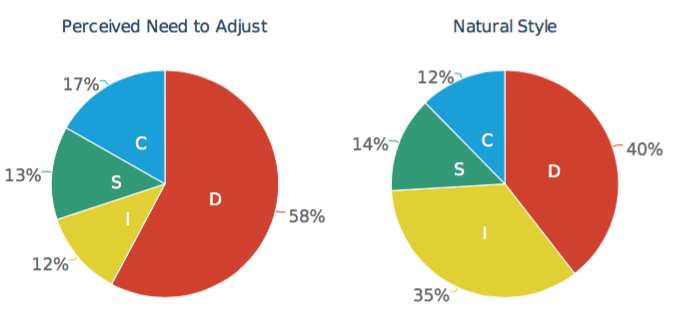The strengths of your DISC-style can hinder your success. Learn skills to capitalize on your style’s strengths while working on your development areas.

Don’t Overuse Your Strengths
One topic that almost always comes up in our DISC train-the-trainer sessions is how to best handle questions by training participants about their own development areas. The main reason for this is that the respondents of the DISC questionnaire rarely have any questions about their strengths. This is because no one disagrees with his or her own strengths. Everyone readily accepts them since who does not like to be reminded how wonderful we are. However, accepting our development areas requires a little more objectivity and maturity.
While our strengths are certainly wonderful, many of us actually struggle with them more than with our development areas. Our strengths often create more significant roadblocks to our success and they frequently create challenges for us.
Challenges with Our Behavioral Strengths
First, we tend to overlook our strengths. If you have ever observed someone review their Extended DISC assessment, there is a good chance you noticed the person spent more time reviewing development areas while the strengths only received a cursory look. We are conditioned to focus on what we “got wrong” and do not give ourselves enough credit for what we “got right”. While the DISC-model makes absolutely no value judgments and there are no right or wrong results, our natural tendency is to overlook our very valuable strengths.
Also a challenge with strengths is that quite a few of us assume that everyone else also possesses the same behavioral assets. As a result, we take them for granted. However, others do not share your strengths. Trust me, many would love to have your strengths. Do not overlook them. Value and capitalize on your strengths.
Our strengths can also hold us back since almost all of us are prone to stay in our behavioral comfort zone. It is much easier to “autopilot” than to expend the energy to consciously modify behavior for more successful outcomes. As a result, we are more likely to emphasize, and overuse, the behaviors that are the most comfortable to us. Yes, you guessed it – these are our strengths.
Becoming Too Much of Ourselves
When we overuse our strengths, essentially we become too much of ourselves. I call this the “too- effect’. If you look at the adjectives used to describe your DISC-style, simply add the word “too” in front of those descriptors of your behavioral style. In others words, if you are a D-style, you are too direct. In case you are an I-style, you are too talkative. If you happen to be an S-style, you are too modest. And as a C-style, you are too analytical. And so on for all the attributes of your style.
This is exactly what happens when we overuse our strengths. As a result, others around us are not going to respond well to our behavior. Because we may be an abrasive D, an unrealistic I, a complacent S, or a critical C, the results are not going to what we want and expect. This makes us frustrated, stressed and pressured, which in turn makes us to revert to our natural DISC-style and to amplify our strengths even more. (If you read the section “Reactions to Pressure Situations” in your Extended DISC assessment, you will discover exactly how you are likely to behave in these situations.) This is turn elicits even worse reaction from others, adding to the pressure and the downward spiral continues and accelerates. In fact, instead of just reverting to our natural style, we begin to exhibit the negative traits of our DISC-style. Our strengths have become our liabilities.
Behavioral Modification vs. Stress, Emotions and Fatigue
What can we do to prevent this? Awareness is a must. We need pay particular attention to three things:
- Stress
- Emotions
- Fatigue.
Whenever we are stressed, we are less likely to modify our behavior. Stress is a distraction that keeps us from making conscious adjustments to our style. Of course, stress is ubiquitous but we need to be aware when the stress level becomes high. When that happens, we need to be particularly careful not to use strengths too much.
When we get emotional, we stop modifying our behavior and show our worst behavioral traits. Think about the last time you were angry. Did you make conscious decisions about how to best adjust your style to achieve the best outcomes? Think about the last fight you had with a friend, family member or a co-worker. Did you remember to adjust your communication style?
Strong emotions are the enemy of behavioral modification. Don’t forget this to maintain your awareness to not allow your strengths to become liabilities.
Modifying behavior takes energy. Fatigue works against you. When you are tired, be vigilant not to become lackadaisical. It may be a good idea to take a break or postpone an important interaction. This is one reason why physically fit people perform at a higher level. Exercise, healthy diet, and rest improve our ability to modify behavior.
Not surprisingly, everything comes down to making conscious decisions about modifying behavior. Sometimes we just do not feel like doing it. We have little energy or are not motivated. When this happens, focus on the big picture. Ask yourself: “What is the cost of not adjusting my behavior?” This often helps put everything into perspective.
You can also think about the value of the interaction. What type of return on your effort will you get? This is particularly helpful question when interacting with your loved ones. Expending the required energy to adjust your style when communicating your child could make an incredible difference.
What Can We Do to Not to Overuse our Behavioral Strengths
What about a few techniques to help not to overuse strengths? First, slow down and be present. You need to be aware how you are behaving. Aim to keep calm and control your emotions. Remember, when you become emotional you stop adjusting. Finally, keep the end goal in mind and focus on how to modify your behavior.
Yes, it takes energy not to autopilot. However, you will be more successful and will spend a lot less energy and effort over time not having to fix problems your overused strengths can create.
Everything in moderation. Even with our wonderful strengths. Use, but not abuse, them.
